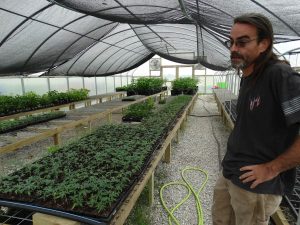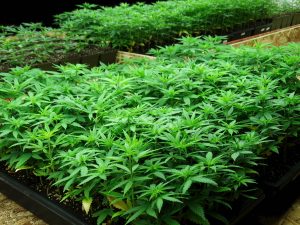Illinois hemp farmers leverage high risk for high profit potential
By Peter Hancock Capitol News Illinois — June 19, 2019
Trent Lawrence, who grows industrial hemp on his 26-acre farm near Delavan, called the venture “very risky.” Hemp is a new crop on Lawrence’s farm, just as it is for 473 other growers who have been issued licenses by the state since the application process began April 30. (Photo by Peter Hancock/Capitol News Illinois)
SPRINGFIELD — Trent Lawrence had a rude awakening earlier this week. Overnight, mice had gotten into the greenhouse on his farm and eaten several dozen trays of seedlings he was planning to transplant into a field.
Lawrence and his wife, Jami, work a 26-acre farm outside of Delavan, about 30 miles south of Peoria, in Tazewell County. For the past several years, they’ve been growing organic peppers, tomatoes and a variety of other specialty crops. But this year, they’re starting a new crop that became legal in Illinois only earlier this year, industrial hemp, and that’s what the mice found especially tasty.
At a cost ranging from 25 cents to $1 per seed, rodents in the greenhouse are just one of many risks that Illinois hemp farmers face.
“It’s very risky, very risky,” Lawrence said during an interview on his farm.
Fortunately for Lawrence, the damage was minimal. He has hundreds more seedlings growing in that same greenhouse, and hundreds more on top of that germinating under lights in an upstairs room of the house that sits on the property.
With luck, each of those plants will grow to produce one to two pounds of flower rich in a compound called cannabidiol, more commonly known as CBD, which when extracted can be used to control a wide range of medical conditions including seizure disorders. And with market prices ranging from $80 to $100 a pound, depending on its CBD content, that makes each one of those seedlings extremely valuable.
That industry, however, became possible only in recent years. Since the 1930s, industrial hemp had been illegal in the United States, with a brief exception during World War II, because it was classified as a narcotic in the same category as marijuana. It was only in 2014 that Congress began allowing states to authorize limited production for research purposes, and it was finally legalized completely in the 2018 Farm Bill, which Congress passed in December.
“Six months ago, this would have been the mother of all felonies,” Lawrence said as he looked around his greenhouse. “It’s no joke. Until the 2018 Farm Bill was signed, it was still under controlled substance territory. This would have been a Schedule I drug, but since they deregulated CBD — they removed CBD out of the Schedule I drug category.”
Lawrence said the plants classify as industrial hemp as long as they test below 0.3 percent Tetrahydrocannabinol, more commonly known as THC, the principal psychoactive ingredient in marijuana.
“So, we can grow a CBD crop now, as long as we don’t go above 0.3 percent delta-9-THC,” he said.

Industrial hemp grows in a greenhouse on the farm operated by Trent Lawrence and his wife, Jami, near Delavan. The Lawrences have hundreds of seedlings growing in the greenhouse and under lights in an upstairs room of the house that sits on the property. (Photo by Peter Hancock/Capitol News Illinois)
The Illinois Department of Agriculture began accepting applications for licenses to grow industrial hemp on April 30, and as of June 10, according to agency figures, the state had issued licenses to 474 growers covering just over 12,103 acres.
That’s actually quite small compared to the 11 million acres of corn the state produced in 2017, or the 10 million acres of soybeans farmers grew that same year.
In terms of income potential, however, there is little comparison. In 2017, according to the Illinois Department of Agriculture, corn production in Illinois averaged 201 bushels per acre, and it sold for $3.35 a bushel, or $673.35 per acre. Soybeans yielded roughly $556.80 per acre.
But some in the industry believe a quality hemp crop that’s geared toward CBD production could generate as much $90,000 to $160,000 an acre, depending on how much flower the plants yield and how much CBD they contain.
“It’s just that the CBD craze that’s going on right now has produced some pretty tremendous stories of farmers and what they can earn on an acre of hemp flower,” said Kevin Pilarski, chief commercial officer of Revolution Cannabis in Elmhurst.
Different varieties of hemp can be grown for its fiber, or to produce seeds. But for now, Pilarski said, Illinois farmers are focusing exclusively on CBD production.
But for farmers hoping to cash in on that market, there are also substantial risks.
Ginger Duer, president and founder of Delta Valley Logistics, a company that grows industrial hemp in Illinois, California and Ontario, said the first of those is upfront capital investment.
“I tell our farmers to anticipate spending — from before they purchase seeds to when they have a salable biomass at the end of the product cycle, they have a product that is dried, packaged and ready to sell to a processor — $15,000 to $20,000 an acre,” Duer said. “Now, that is making an assumption that the farmer does not have a lot of equipment that they’re going to have to obtain. However, for the vast majority of farmers, you do have that equipment.”
Both Duer and Lawrence acknowledged another risk about the hemp industry: the fact that there is no accredited crop insurance for it yet.
“Every farmer out there who’s currently growing hemp is running naked,” Duer said. “But that’s causing other problems within the hemp markets because it’s making it more difficult to pre-sell their crop because there’s no crop insurance.”
In addition, she said, there are no certified industrial hemp seeds available yet, which makes shopping for seeds a risky venture of its own because of what she described as “rampant fraud” in the hemp seed market.
“We’re talking about people selling seed stock that is two to three years old as ‘fresh’ seed stock, so the germination rates are 50 to 60 percent instead of above 95,” she said. “You have people selling seeds that were pollinated by high-THC drift in certain states and areas of the country, leading to farmers planting plants that they believe are going to be industrial hemp but are legally marijuana and have up to 6 to 7 percent THC by harvest.”
Lawrence, who said he purchased seeds from hemp farmers in Colorado and Oregon, where production has been legal for some time, said he experienced the uncertainty of the seed market as soon as he decided to go into production.
“Imagine doing a wire transfer for $10,000 or $20,000 with somebody in another state that you’ve never met for something that was, six months ago, a felony,” he said.
In addition, he said, even though the seeds came from plants that met the standards for industrial hemp in another state, that does not necessarily predict how they will grow in the fertile soils and hot summers of Illinois. There is always a danger, he said, that the plants will end up producing too much THC.
“Before we harvest, the state will come in and take samples, send those in and get our levels, and if it tests over a certain percent, we have to burn the crop,” he said.
Duer said she believes the hemp industry in the United States will never fully stabilize until there is crop insurance available and there are controlled, certified seeds available to farmers.
Lawrence, however, remains optimistic that will eventually happen.
“I’m thinking in another four or five years, this is going to be just like any other commodity,” he said. “Once more farmers start doing this, especially with grain and fiber, once the infrastructure for those crops is in place for processing grain and fiber, I think this will go mainstream. We’ll have corn, beans and hemp growing everywhere.”






